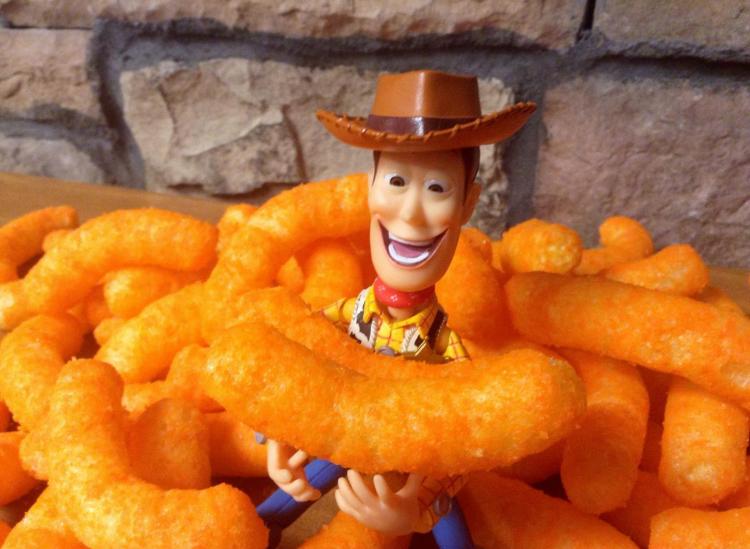11 Weird Facts You Didn’t Know About Cheetos

Flickr
The signature orange dust that coats our favorite chip is pretty addictive. From the cheesy flavor to the airy crunch, Cheetos are a nostalgic snack that never seems to get old. Whether you down a family-sized bag in one sitting or have to get your Flamin’ Hot fix every time you walk into a gas station, these chips are nearly impossible to resist. After all, if it weren’t for Cheetos we wouldn’t know the thrill of having orange-stained fingers. Here are 11 weird Cheetos facts you didn’t know.
1. A Janitor Invented Flamin’ Hot Cheetos
Richard Montanez, a Mexico native, was a janitor in the Frito-Lay Rancho Cucamonga plant in California in 1976 when he realized chili powder was the spicy kick Cheetos needed. He pitched his recipe to the CEO and soon after, Flamin’ Hot Cheetos became one of Frito-Lay’s most lucrative launches. Now Montanez is the vice president of multicultural sales for PepsiCo America.
2. Cheetos Mystery Colorz Were The First Snack Designed To Color Your Tongue
Back when Cheetos Mystery Colorz were introduced in early the 2000s, you could expect your tongue to be stained just like your fingers. It was completely up in the air if your tongue was going to turn blue or green.
3. Michael Jackson Moonwalk Cheeto Sold On eBay for $35
Yup, people are weird. Someone discovered a Michael Jackson Moonwalk-shaped Cheeto and sold it on eBay for $35.
4. It Takes More Than 10 Million Pounds Of Cheese To Make A Year’s Worth Of Cheetos
A year-long production of Cheetos requires about 11 million or more gallons of milk and 10 million pounds of cheese to make the seasoning. Thank you to the cows who have made everyone’s favorite cheesy snack possible.
5. The Original Mascot Wasn’t Chester Cheetah, It Was A Mouse
Before the effortlessly cool and iconic Chester Cheetah came to town, a motorcycling mouse played the mascot role. The mouse first appeared in 1971 and was a demure predecessor to the latter, more rambunctious Cheetah who debuted in 1986.
6. Cheetos Are Designed To Be Addictive
The New York Times reports that Cheetos are addictive for a reason. Steven Witherly says, they’re “one of the most marvelously constructed foods on the planet, in terms of pleasure.” The puffs melt in your mouth, which he calls “vanishing caloric density.” As the cheesy puff essentially dissolves, it can be easy to feel less than full and keep on snacking.
7. The Cheesy Secret Is Linked To The U.S. Military
Frito’s founder, C.E. Doolin wanted to bring the savory taste of cheese into the world of packaged snacks. Luckily, the U.S. military pioneered the research into dehydrated cheese in the hopes of adding it into dried military meals. Powdered cheese was born and added to our favorite orange-dusted snack.
8. The World’s Largest Cheeto Is In Iowa
For those of you who consider yourselves Cheeto fanatics, check out the world’s largest chip in Algona, Iowa. The famed orange nugget is roughly the size of a lemon and was originally found in a bag of Cheetos in Hawaii. It was put up for auction on eBay but the bidding quickly became absurd, with offers for over $1 million. The seller instead donated the Cheeto, which now sits upon a small velvet pillow in a local Iowa restaurant.
9. They’re More Than Just A Cheesy Snack
Flavors like peanut butter, avocado salad, coconut curry, rock taco and winter cheese can be found in foreign countries. You might prefer the cheesy classic, but feel free to give a sausage flavored Cheeto a try.
10. Cheetos Are Made In 22 Countries
Even though the crunchy orange puffs are considered an American classic, they’re produced in 22 different countries including Pakistan, Spain and Cyprus.
11. Flamin’ Hot Cheetos Are Banned In A Lot Of Schools
These “Flamin’ Hot” bandits will leave your fingertips bright red. Several schools in California, New Mexico and Illinois have banned these high-salt and high-fat snacks. The lack of nutritional value is the main reason behind the strict snacking rules. Other concerns are kids sharing them and spreading germs, as well as the food’s messiness.











